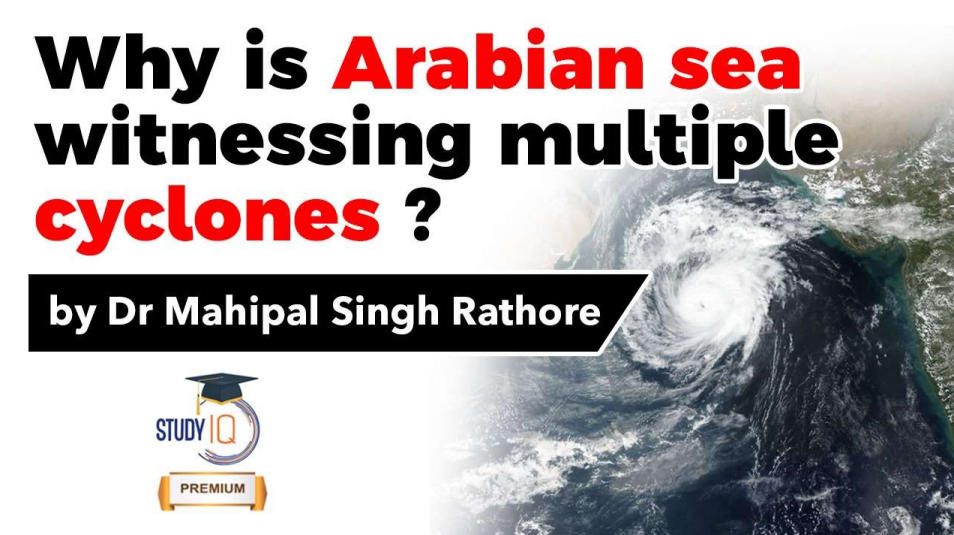Table of Contents

2019 North Indian Ocean Cyclone season
- This year has recorded one of the most active cyclone seasons in the North Indian Ocean with seven cyclonic storms
- A record-breaking six of them intensifying to very severe cyclonic storms and one to super cyclonic storm, Kyarr.
- 4 major cyclonic storms formed off the coast of India in the Arabian Sea – Vayu, Hikaa,Kyarr and Maha.
Naming of Cyclones – Match the following

Cyclogenesis
- The cyclones that occur between Tropics of Cancer and Capricorn are known as Tropical Cyclones.
- Tropical cyclones are weather systems in which winds equal or exceed gale force (minimum of 34 knot, i.e., 62 kmph).
- Indian sub-continent is the worst affected region of the world, having a coast line of 7516 kms.
- Exposed to nearly 10% of the world’s Tropical Cyclones.
- Cyclones occur in the month of May-June and OctoberNovember.
Bay of Bengal vs Arabian sea
- The occurrence of cyclones is more frequent and common in the Bay of Bengal compared to the Arabian Sea.
- However, in recent years, the latter has also seen its share of cyclones.
- This growing cyclogenesis and formation of intense cyclones in the Arabian Sea could be linked to global warming and is seen as an effect of climate change.
- An analysis of the frequencies of cyclones on the East and West coasts of India during 1891-2000 show that nearly 308 cyclones (out of which 103 were severe) affected the East Coast.
- During the same period 48 tropical cyclones crossed the West Coast, of which 24 were severe cyclonic storms.
- In the Bay of Bengal – 58 % approach and cross the East Coast
- In Arabian sea – 25 % approach and cross the West Coast.
- Reason for less storms forming over Arabian sea – because of cooler sea surface temperatures
- On average 1–2 tropical cyclones form over the Arabian Sea each year, and few of these storms are intense enough to be classified as very severe or super cyclonic storms.
IMD Classification

- Recurring cyclones account for large number of deaths, loss of livelihood opportunities, loss of public and private property and severe damage to infrastructure, thus seriously reversing the developmental gains at regular intervals

Why the increased frequency?
- The behaviour of all storms can change rapidly due to changing environmental conditions near them.
- Cyclonic storms have become difficult to predict in the past few years due to warming sea surfaces and decreasing wind speeds, as was observed with Fani.
- According to the India Meteorological Department (IMD), the Sea Surface Temperatures (SST), or simply, the temperature of sea water recorded at the surface, was higher than normal over the Arabian Sea since October, towards the culmination of the southwest monsoon season.
- Generally, such higher SSTs favour the formation of ocean systems like depression that can, over a short period of time, intensify into cyclones or super cyclones while at sea.
- A strong Indian Ocean Dipole (IOD) contributing to the Northeast Monsoon rains, particularly over the southern peninsular region.

What is IOD?
- The Indian Ocean Dipole (IOD), also known as the Indian Niño, is an irregular oscillation of sea-surface temperatures in which the western Indian Ocean becomes alternately warmer and then colder than the eastern part of the ocean.
- A positive phase sees greater-than-average sea-surface temperatures and greater precipitation in the western Indian Ocean region, with a corresponding cooling of waters in the eastern Indian Ocean—which tends to cause droughts in adjacent land areas of Indonesia and Australia.


Other factors at work
- A huge change occurred in the year 1976, when scientists across the world confirmed a sharp rise in temperature in the Pacific Ocean’s equatorial region.
- The Sea Surface Temperature or SST of the Pacific Ocean rose suddenly and affected the atmospheric dynamics and wind patterns across the planet

- The excess heat energy in the Western Pacific Ocean was transferred to the South Indian Ocean via the Indonesian Throughflow (ITF), a low altitude, oceanic pathway for warm, fresh water to move between the two ocean basins.
- ITF, among other factors, that has led to a noticeable increase in the Indian Ocean’s sea surface temperature or SST over the decades.
- The rise in SST also explains how the monsoon behaviour in the country has noticeably changed, with extreme rainfall resulting in landslides and flooding in several places.
Naming of cyclones
- For the Indian Ocean region, deliberations for naming cyclones began in 2000 and a formula was agreed upon in 2004.
- Eight countries in the region – Bangladesh, India, Maldives, Myanmar, Oman, Pakistan, Sri Lanka and Thailand – all contributed a set of names which are assigned sequentially whenever a cyclonic storm develops.

Latest Burning Issues | Free PDF






















 WhatsApp
WhatsApp